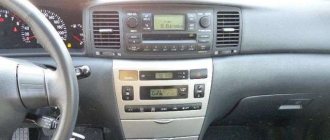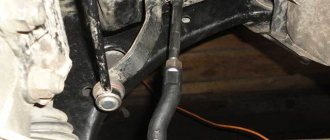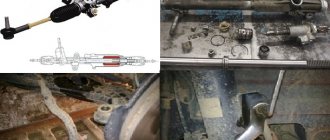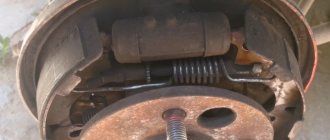4589 Apr 20
Toyota Corolla is a fairly durable car, and long-term use rarely causes serious wear and tear on the car. However, machine maintenance must be carried out promptly and regularly to avoid unexpected problems. One of the most common faults on Corollas 150 and 120 is floating idle speed. You can get rid of such a failure yourself, but to do this you need to know not only how to fix it, but also the cause of the problem.
Toyota Corolla idle speed fluctuates
Toyota Corolla is a fairly durable car, and long-term use rarely causes serious wear and tear on the car. However, machine maintenance must be carried out promptly and regularly to avoid unexpected problems. One of the most common faults on Corollas 150 and 120 is floating idle speed. You can get rid of such a failure yourself, but to do this you need to know not only how to fix it, but also the cause of the problem.
Where do floating speeds come from?
This type of malfunction mostly appears in vehicles equipped with an electronic fuel injection system. The malfunction essentially occurs in the computer responsible for supplying air to the engine. The latter is necessary to create a combustible mixture, so it must enter the cylinders in a strictly defined quantity.
If a problem occurs, excess air enters the power system, causing the throttle sensor to react.
It transmits information about fuel oversaturation to the computer. As a result, the devices conflict, which is why the speed fluctuates. They can vary from 800 to 1200 rpm, with jumps occurring at intervals of 2-6 seconds.
Why is this harmful to the car? The fact is that the constant alternation of low and high speeds noticeably increases fuel consumption and, naturally, causes malfunctions of the power system, which may well lead to additional breakdowns and significant costs for complex repairs and replacement of parts. That is why you should keep the situation under control and resolve problems in a timely manner.
On the E151 type Corolla, the speed fluctuates quite often, because starting from 2012, the car is equipped with a new electronic fuel injection system.
Its vulnerability is that when the car is used for a long time without timely maintenance, the sensors gradually get lost. The 2007–2008 Corolla models have an electronic system, although vehicles in the series until 2002 had a mechanical one. The latter was more vulnerable, and it was also quite difficult to repair. However, the repair procedure for both the new and old versions is the same.
It stalls when stopped at a traffic light.
No. 1 Maxim G
- Users
- 1 messages
- Your car?: Toyota corolla
- Top
- Answer
- Quote
No. 2 Roman5287
- City of Nizhny Novgorod
- Your car?: Corolla e 180
Auto disassembly, I love it.
- Top
- Answer
- Quote
No. 3 Guver
- Your car?: BMW
My father-in-law had the same problem, but he didn’t have it from 2007, but much older, she was already twenty years old. Well, the problem here may most likely be with the box. There is not enough pressure in the box, and when it is not enough, then there may already be a reason. Well, at least that was his problem. Although the security may be broken, in general it needs to be looked at by an electrician.
- Top
- Answer
- Quote
No. 4 Ruslan_Lazarevich
- Top
- Answer
- Quote
No. 5 Alena_Lo
Plus the fuel filter. Take a look at the electronics in the service department; there is also computer diagnostics. On my own behalf, I’ll add that I encountered such a problem due to a poor connection of the battery terminals, when they do not fit tightly enough, and after a slight “shake” such as when crossing tram tracks, you can then suddenly stall somewhere at a traffic light.
- Top
- Answer
- Quote
No. 6 Sergey Gasparov
If the gearbox is a robot, it may stall because of it. The first symptoms, as usual, appear when you begin to feel the gear shift strongly, when the shifts are prolonged. A friend of mine had such a problem, but her car was a Mitsubishi Colt, the repair cost her 40 thousand in wood. Just as mentioned above, there may be a problem with the air filter.
- Top
- Answer
- Quote
No. 7 Ivan Mukhin
- Your car?: Korola
What is your idle speed (how many revolutions)? Perhaps this is the problem. Also, you still need to clarify whether it stalls when you warm it up?
In general, it’s not so difficult to go to a service station and just get a consultation, for such consultations they won’t charge you much, if the service station is small, then about a hundred rubles (this is only for a consultation), then you can read about this problem on the Internet.
- Top
- Answer
- Quote
No. 8 felix
There was such a problem due to the alarm installation curve. After starting the engine from the key fob, according to the instructions, it was necessary to remove it from the handbrake. Since I didn’t use the handbrake when parking (automatic), while driving, the alarm assumed that I was driving with the handbrake, and often turned off the engine at the first traffic light. So you can dig in this direction.
- Top
- Answer
- Quote
No. 9 Alexander_Dmitrievich
What is your idle speed (how many revolutions)? Perhaps this is the problem. Also, you still need to clarify whether it stalls when you warm it up?
In general, it’s not so difficult to go to a service station and just get a consultation, for such consultations they won’t charge you much, if the service station is small, then about a hundred rubles (this is only for a consultation), then you can read about this problem on the Internet.
I think you should first just read a little on the Internet and draw conclusions about what to ask. And then service stations are also different. If the problem is in the actuator, then they may offer their own used version, but it is not at all a guarantee that it will turn out to be good. It might be better to know the prices, and if you want to come and buy something online, from trusted sellers. Otherwise, everyone can beat the prices, but it’s important to navigate them!
- Top
- Answer
- Quote
No. 10 Vasya_Pupkin
In many cases, the car stalls when starting from a stop due to a change in the gasoline-air ratio in the combustible mixture. But the reasons for this can, of course, be different. First of all, because of the filters. Dirty fuel filter - not enough gasoline, too much air, you'll stall. Dirty air - not enough air, too much gasoline, you'll stall. There are other reasons besides filters. And you don’t always find them right away.
- Top
- Answer
- Quote
No. 11 Joe
I am sure that along with the fact that your car is stalling, you also have problems with the fact that the revolutions constantly fluctuate. I'm right? So I advise you to clean the throttle valve and everything will be fine for you. Or replace it as a whole.
- Top
- Answer
- Quote
No. 12 Besenok
- Moscow city
- Your car?: Lexus IS
Hello, I bought a Toyota Carolla in 2007, and in the same year I started noticing a problem. Not always, but often the car stalls when I stop at a traffic light, and not at the moment of stopping, but on the contrary, when, after stopping, I start moving. During the inspection they say that everything is fine and there are no problems, what to do and where to turn I have no idea. Has anyone encountered a similar problem and knows what to do in such cases?
It’s not logical and it might even sound stupid, but maybe you just haven’t learned how to feel the car yet and therefore can’t get going normally. After all, the problem does not always arise, which means there are times when everything is fine. But the other options mentioned are worth checking out.
- Top
- Answer
- Quote
How to fix a system crash
The most common powerplant on Corollas of different years of production is a 1.6-liter 4-cylinder gasoline engine. The repair process will be considered on this unit. The first step is to tighten the adjustment screw. This will make the air supply more stable. In addition, due to this, excess fuel will be lost. Another option that is definitely worth trying is compressing the rubber pipes. By pinching one of the parts, you need to see if the speed equalizes. If this works, then you should carefully remove the pipe.
This operation will allow you to determine the source of excess air masses. In fact, they can be the following parts: an engine starting device, a valve (especially the crankcase ventilation valve), as well as a speed control mechanism.
However, it is likely that the number of revolutions rises and falls for a completely different reason. In this case, it is worth dismantling the air duct. As a result, a small hole will appear in front of the throttle (literally 8–10 mm in diameter). You should close it with something tight and check whether the air escapes past the damper. If the problem persists, you need to pay attention to the sensors. They may be dirty or damaged. The check should be entrusted to a specialist who can assess the performance of the parts at idle and replace them if they break. The car owner himself can clean the damper.
How to clean the throttle body
Indeed, as practice has shown, a fairly common reason for a significant drop in speed (or, on the contrary, rise) is a clogged throttle valve.
To clean this small but extremely important part, you need to use a special detergent that is used for carburetors.
You'll also need a dry, lint-free cloth (it's best to use a lot of small ones to clean multiple times), as well as a couple of wrenches and screwdrivers.
First of all, the throttle cable, sensors and pipe are disconnected. After dismantling these parts, you need to unscrew the throttle mount and disconnect the assembly with the damper. Most often, there is a large amount of dust and dirt on it, which directly affects the operation of the throttle. The part must be thoroughly treated with detergent, and after 20 minutes rinsed with gasoline. Use rags to gently wipe the part dry, dry it, and then install it.
Idle speed fluctuates
If the engine idle speed fluctuates
Typically, this effect occurs in engines with electronic fuel injection and is associated, as already mentioned, with abnormal air leaks. The fact is that injection engines have a control unit, or as it is also called, a computer.
This computer calculates the amount of air entering the cylinders and, taking into account the state of a number of sensors, opens the solenoid valves of the injectors (or one injector, if the system is Ci) at one time or another. And so, when “extra” air comes in, and the throttle position sensor “says” that there shouldn’t be any, the temperature sensor says that the engine has already left the warm-up mode and less fuel needs to be poured, as a result, “that computer” has a “roof” is traveling,” he doesn’t know what to do with this “extra” air.
This whole situation leads to the fact that the engine speed periodically begins to change: then 800 rpm, then 1200 rpm, and so on with a period of about 3 seconds. We can also say that in this case the automatic regulation of the power system is disrupted.
We act in this situation simply. First we try to tighten the speed adjustment screw. With this we block the hole through which air enters for operation in unstable mode. Then it may coincide that the “extra” air will ensure operation in this mode. If this operation does not give the desired result, then using pliers we squeeze all the rubber tubes one by one. If, when a tube is pinched, the engine speed levels out and becomes stable, then you need to disconnect this tube (remove it from the pipe) and determine, by plugging the hole with your fingers, where, on which side, the “excess” air is coming from. After that, we “approach” some device through the tube. Here you will need to figure out what kind of device this is and why it allows air to pass through. Most likely it will be a starting device, a device for maintaining speed, or some kind of valve, most often a crankcase ventilation valve. The first two devices are made so that, in certain cases, air flows into the intake manifold through them, bypassing the throttle valve. Based on the amount of this air, the control unit must add fuel if this amount is consistent with the readings of other sensors. But if, for example, the engine has already overheated, and the bellows in the warming device has not closed its valve, and air continues to flow through it into the manifold, bypassing the throttle valve, then this air becomes “extra.” On some engines (Toyota 1G), the heating device is made integral with the throttle body (on engine 10 it is located below, under the throttle body) and then there are no rubber tubes.
Engine speed fluctuates: symptoms and main causes
First of all, the tachometer helps to notice floating speed. Most often, the floating speed appears at idle. Normally, even on a slightly warmed-up engine, the tachometer needle should remain stable at about 800 rpm while idling.
The only exception is the warm-up speed XX, when the ECU on injection engines itself raises the speed to 1000-1100 rpm. In this case, after the engine temperature rises slightly, the control unit will lower the idle speed to the desired level of 750-800 rpm.
Revs fluctuate on Toyota Corolla: causes and their elimination
Long-term operation of automotive equipment without servicing its components, as a rule, leads to breakdowns or malfunctions in the operation of certain systems. Any car needs constant attention and care. In this article we will discuss the problem when the speed fluctuates on a Toyota Corolla, we will try to understand it and fix it.
Floating speed of a car in our country is a very common problem that has affected any car owner at least once. The problem can arise for various reasons, and now we will talk about it.
Why can the idle speed fluctuate?
The effect of floating speed occurs most often in cars with electronic fuel injection and is associated with excessive air supply. Here the whole problem rests on the system control unit or the computer, which regulates the air supply to the overall system.
The computer must provide a sufficient amount of air entering the cylinders, while taking into account the readings of a number of sensors. After processing and reading information from the latter, the computer opens the injector solenoid valves at one time or another. When a failure occurs and excess air enters, the throttle sensor indicates that there has been an oversaturation of air and it should not be there, and the temperature sensor dictates its rules to the control unit and indicates that the engine has already left the warm-up and air-saturated mode Less fuel needs to be poured. As a result of a sensor conflict, the computer has a problem - it does not understand where to put the excess air. This whole situation, as a rule, leads to the fact that engine speeds begin to fluctuate from 800 rpm, then 1200 rpm, and so a periodicity of 3-5 seconds occurs. Floating speeds cause great inconvenience for the driver, increase fuel consumption and disrupt the operation of the fuel supply system. If such a problem occurs, it must be eliminated.
If such a situation arises, we will try to correct the situation ourselves. First, let's tighten the speed control screw - by doing so we will close the hole through which the air enters and we will be able to stabilize the air supply. By tightening the bolt, the excess rich mixture should be compensated. If this operation does not give the effect we need and does not restore the speed, we can try to squeeze the rubber tubes; if, by squeezing one of the tubes, the engine speed levels out and becomes quite stable, we need to remove it from the pipe and determine where the excess air is coming from. The most common causes of excess air are devices such as:
- Starting device for Toyota Corolla;
- Device for maintaining speed;
- Any valve;
- Or, as practice shows, the crankcase ventilation valve of a Toyota Corolla engine.
If, after all the tubes were clamped one by one, a solution to the problem was not found, you can safely remove the air duct in front of the throttle valve. Having removed it, in front of the throttle valve you can find a hole with a diameter of about 1 centimeter - through this hole air flows bypassing the throttle valve. It’s worth starting the engine and plugging the hole with your fingers; if this doesn’t help, then let’s move on to the next possible cause of floating speed.
It’s worth checking all the sensors - we check for contamination and external damage; for a more detailed inspection, you will need a specialist who can test the car’s sensors; if the specialist finds nothing, we check the throttle cable. It should be reasonably tensioned, but should not initially open the throttle assembly. If everything is in order with the cable, the tubes have no damage or obvious cracks, there is only one reason for this behavior of the car - a clogged throttle valve.
Step-by-step cleaning of the throttle body on a Toyota Corolla
So, let's start cleaning the throttle. First, it’s worth talking about exactly what tools we need. For removal and cleaning we need:
- Special product for cleaning carburetors;
- A few clean and dry rags, preferably lint-free;
- A set of keys, various sockets and screwdrivers - which will help in removing the throttle;
- You also need a room in which the relevant work can be carried out.
Having decided on the tools and materials, we proceed to removing the throttle. Disconnect the pipe, throttle cable and two sensors. The photo below shows where the throttle is located.
Next, we need to unscrew the bolts securing the damper - unscrew several nuts and bolts, and then carefully remove the damper from its place. This is not difficult to do, but you should be careful and careful not to damage the unit. So, the knot is removed. The photo below shows what a dirty throttle valve looks like. It is because of this dirt that instability of engine operation and floating speed on the tachometer can occur.
We removed the throttle. We take the aerosol we bought for cleaning carburetors and thoroughly spray the entire throttle body, both inside and out. It is important to remember that it is best to use chemical-resistant gloves, as the aerosol is very caustic. We spray and wait 20-30 minutes until the applied liquid corrodes the dirt and it can not be easily washed off.
After waiting a little time, we wash the throttle with gasoline, then wipe it clean and let it dry. It is advisable to carry out cleaning in a place without drafts and wind, so that dust does not get stuck in the various cracks of the damper. The photo below shows what a clean damper looks like. This is exactly the result we should strive for.
After all cleaning, we put the damper back on, not forgetting to put on the sensors, throttle cable and air duct. We start the car and check its performance. Most likely, the speed will return to its previous position, the car will work quietly and calmly, as if you had just bought it.
This concludes cleaning the damper, searching for the problem and eliminating it. When the cause of the breakdown has been eliminated, it is worth talking about how to prevent such phenomena from occurring:
- The first and most important thing is to change the air filters in a timely manner and not let the car become covered in dust;
- The second and also no less important is that you, as a driver, should look for normal, clean fuel for your car - you should not refuel your car at dubious gas stations;
- And finally, thirdly, the car needs timely maintenance - the throttle valve should be cleaned at least once every 10-15 thousand kilometers. This point is mandatory, because at one point the car will simply let you down.
We'll stop there. The three points presented are mandatory, since next time the car simply will not start. Timely inspection and cleaning of your car will help significantly save your money and minimize your digging under the hood to find problems.
Reviews from Toyota Corolla owners about their cars:
If everything is in order with the cable, the tubes have no damage or obvious cracks, there is only one reason for this behavior of the car - a clogged throttle valve. Step-by-step cleaning of the throttle valve on a Toyota Corolla So, let's start cleaning the throttle. First, it’s worth talking about exactly what tools we need.
To remove and clean we will need: A special product for cleaning carburetors; A few clean and dry rags, preferably lint-free; A set of keys, various sockets and screwdrivers - which will help in removing the throttle; You also need a room in which the relevant work can be carried out. Having decided on the tools and materials, we proceed to removing the throttle. Disconnect the pipe, throttle cable and two sensors.
Knocking noise in the steering mechanism
In general, the Corolla 150 steering rack rarely presents problems and has a long service life. A knock in the steering wheel usually appears when the mileage approaches 100 thousand km. Its cause is a worn bushing. Driving over minor road irregularities is accompanied by characteristic sounds, signaling the need for repairs.
Usually, if the bushing fails, the car owner can operate the car for 10-15 thousand km without making a replacement. In this case, wear of the parts interconnected with the bushing occurs, and the comfort and safety of driving the car decreases. Therefore, if a knocking noise occurs in the steering wheel, you should not delay replacing worn out elements.
Electrical troubles
From time to time, in cars with mileage of more than 200 thousand km, minor electrical problems appear. The most inconvenient thing is the sound signal. It is located in a place where it is constantly exposed to an aggressive environment. This leads to instability of the audio signal.
During repair work, it is possible that the airbag wiring, which is located in the steering column, may break. This is due to an unsuccessful layout and too short cable length.
On cars whose mileage approaches 400-450 thousand km, problems arise with chafing of the electrical wiring. If the fuse box is in poor condition, the machine may catch fire.
Unstable operation of the power plant
Unstable engine operation can manifest itself in several ways:
- idle speed fluctuates;
- the power unit does not start or starts with difficulty;
- engine troits;
- Unstable speed during acceleration and while driving.
Idle speed floats usually due to a failure of the idle speed controller. The problem also occurs when air leaks in the throttle assembly.
A typical reason for the difficulty of starting the power plant on the Corolla 150 is wear or damage to the Benedix starter. At the same time, characteristic sounds and clicks are heard from the engine compartment.
Engine trouble is usually due to a faulty spark plug or lack of a normal spray pattern at one of the injectors. Misfires lead to excessive wear of the power plant and related components. The appearance of spark plugs that can lead to engine tripping is shown in the image below.
Failures in the operation of the Corolla 150 engine during acceleration are possible due to malfunctions in the fuel system or due to a failed throttle assembly. Instability of the internal combustion engine is accompanied by an increase in fuel consumption and a deterioration in the dynamic performance of the machine.
Body flaws
The body hardware does not cause any complaints from car owners. Problems with it are present only on cars that have been in accidents.
The only weak point of the Corolla 120 is the rubber bands at the bottom of the doors and windows, located on the outside. After 7-8 years of use, cracks appear on them, which spoil the appearance of the car.
With a mileage of more than 120 thousand km, “crickets” begin to be heard from the engine compartment. Their source is friction on the hood hinge. Most car owners fix this problem by placing a piece of porous soft rubber between the hood and the fender.
Problems with the Corolla body
The body is slightly susceptible to corrosion, so it presents virtually no trouble to the car owner. The metal is much thicker than that of competitive models. It cannot be bent by finger pressure.
Has a body and weak points. Its paint and varnish are thin. At the same time, the paintwork is quite soft, which causes scratches to appear quickly. The consequences of damage to the paintwork can be partially eliminated by polishing.
Increased oil consumption
If the maintenance intervals are observed and the car is operated without significant overloads, the Corolla 150 engine does not consume oil. As a result of engine wear or unresolved malfunctions, a situation arises when excessive lubricant consumption occurs.
Among car owners, it is considered the norm if the engine consumes no more than 500 grams of lubricant per thousand km. The automaker allows consumption of up to a liter for a similar mileage. In most cases, increased oil consumption is caused by stuck piston rings or burnouts in the internal combustion engine.
Suspension failures
The main suspension problems that owners encounter are listed in the table below.
Table - List of suspension problems
| Problem | Note |
| Knock | There are many reasons for knocking. If the sound comes from the wheel arch, then there is a high probability of play appearing at the attachment points of the stabilizer bar. |
| Breakdown | The Corolla 120 suspension is adapted to the domestic road surface, so it cannot be called soft. It does not require attention until 80-90 thousand km. The appearance of breakdowns indicates the need for a suspension overhaul. |
| Violation of wheel alignment angles | If it is impossible to set the correct wheel alignment angle on the stand, troubleshooting of the suspension elements is necessary. The appearance of deformations occurs after hitting a significant road obstacle. Also, the inability to adjust the wheel alignment occurs when there is excessive wear of most suspension parts, which is typical for cars with a mileage of more than 160 thousand km. |
Appearance of vibration
Vibration in the Corolla 150 can have various sources. The most common of them are discussed in the table below.
Table - Description of vibrations that Corolla 150 car owners can detect
| Source of vibration | Note |
| Worn engine mounts | The loss of elastic properties of the power plant cushions is observed when the mileage exceeds 150 thousand km. The vibration changes its frequency and amplitude depending on the engine speed. Its strength often depends on whether the car is accelerating or braking. |
| Brake disc deformation | Violation of the shape of the front brake discs leads to a distinct vibration in the steering rack during braking. For a sporty driving style, Corolla 150 car owners recommend using ventilated or ceramic discs. For many drivers, the standard braking system is not enough for dynamic driving. The brakes are too soft, and the discs often overheat, which leads to their deformation. |
| Suspension | The Corolla 150 suspension is famous for its indestructibility and unpretentiousness. Therefore, many drivers are negligent about its condition. This results in vibrations that usually change in intensity and amplitude depending on the speed of the vehicle. |
Problems Toyota Corolla 150
The Toyota Corolla 150 is a reliable car without significant design flaws, but despite this, every car owner encounters breakdowns.
In most cases, they are caused by improper maintenance or harsh operating conditions. To make it easier to identify problems in the car, self-diagnosis is used. The driver may encounter a situation where there is no dynamics due to the failure of one of the sensors. The information received through the diagnostic connector does not always allow one to identify a faulty meter. In this case, you have to change the proposed sensors and monitor the dynamic performance of the machine.
Clogged filters can also cause poor acceleration. The influence of filter elements on dynamics is discussed in more detail in the table below.
Table - Influence of filters on dynamic indicators
| Filter element | Note |
| Oil filter | The deterioration in dynamics is most noticeable on a cold engine. As the oil warms up and dilutes, the operation of the power plant improves. The check light may come on periodically. Long-term operation of a car with a clogged oil filter leads to premature engine overhaul. |
| Air filter element | A clogged filter does not allow enough air to flow to form the optimal air-fuel mixture. Because of this, the ECU adjusts the operation of the internal combustion engine to the current conditions, which is accompanied by an increase in fuel consumption and a decrease in dynamics. |
| Crankcase gas filter | As a result of its clogging, the intracrankcase pressure increases. This reduces the efficiency of the power plant, which negatively affects dynamic performance. |
Also, the reason for the deterioration in the dynamics of the Toyota Corolla 150 may be the additional load on the engine due to the failure of attachments. A jammed generator or air conditioner can take away significant power from the internal combustion engine. This leads to a decrease in dynamics. Diagnostics is carried out by visual inspection of the attachment and listening to sounds emitted during engine operation from the engine compartment.
A feature of the Corolla 150 is the correction of the composition of the fuel-air mixture depending on the temperature of the power plant. Therefore, failure of the temperature sensor or lack of data in the ECU for other reasons leads to suboptimal engine operation. Moreover, the degree of deterioration in dynamics very often depends on the ambient temperature.
The occurrence of extraneous sounds when the engine is running
Many car owners complain about the water pump. In its standard version it has design flaws. Because of this, the pump may begin to hum when the car’s mileage barely reaches 15-20 thousand km. In most cases, the pump is replaced under warranty.
More serious extraneous sounds occur when fingers tap. This problem can occur with a mileage of 60 thousand km, but usually does not appear until 150-180 thousand km. The problem of knocking fingers needs to be solved by disassembling the engine and replacing them along with the pistons.
Problems in the fuel system
The weak point of the fuel system is its filter. Due to the low quality of domestic fuel, its clogging occurs when the mileage approaches 80 thousand km. Continuing to operate a vehicle with a clogged filter leads to instability of the power plant speed during driving and acceleration. In addition, there is an additional load on the fuel pump, which leads to faster failure. As a result, the cost of repairing the fuel system increases several times.
Clogging of fuel injectors leads to deterioration of the fuel spray pattern in the combustion chamber. Because of this, the characteristics of the power plant deteriorate, fuel consumption increases, and the engine begins to operate unstably. If one of the injectors fails, the engine suffers. In most cases, troubleshooting is possible by washing, but when the mileage reaches 150 thousand km, it is better to replace the failed elements.











